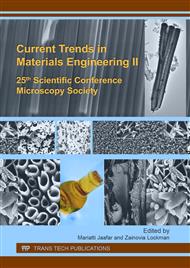[1]
M. Fuji, Y. Shiroki, R. L. Menchavez, H. Takegami, M. Takahashi, H. Suzuki, S. Izuhara, and T. Yokoyama, Fabrication of cordierite filter by in-situ solidification for high temperature dust collection, Powder Technol., vol. 172, no. 1, p.57–62, Mar. (2007).
DOI: 10.1016/j.powtec.2006.10.029
Google Scholar
[2]
J. Luyten, S. Mullens, J. Cooymans, a. -M. De Wilde, and I. Thijs, New Processing Techniques of Ceramic Foams, Adv. Eng. Mater., vol. 5, no. 10, p.715–718, Oct. (2003).
DOI: 10.1002/adem.200300381
Google Scholar
[3]
J. M. Benito, X. Turrillas, G. J. Cuello, a. H. De Aza, S. De Aza, and M. a. Rodríguez, J. Eur. Ceram. Soc., vol. 32, no. 2, p.371–379, Oct. (2011).
DOI: 10.1016/j.jeurceramsoc.2011.09.010
Google Scholar
[4]
R. Bejjaoui, a. Benhammou, L. Nibou, B. Tanouti, J. P. Bonnet, a. Yaacoubi, and a. Ammar, Appl. Clay Sci., vol. 49, no. 3, p.336–340, Jul. (2010).
DOI: 10.1016/j.clay.2010.06.004
Google Scholar
[5]
H. Kim, S. Lee, Y. Han, and J. Park, Control of pore size in ceramic foams: influence of surfactant concentration, Mater. Chem. Phys., vol. 113, p.441–444, (2009).
DOI: 10.1016/j.matchemphys.2008.07.099
Google Scholar
[6]
Suzuki, H., Saito, H., & Hayashi, T. (1992). Thermal and electrical properties of alkoxy-derived cordierite ceramics. Journal of the European Ceramic Society, 9(5), 365–371.
DOI: 10.1016/0955-2219(92)90095-u
Google Scholar
[7]
J. C. Le Huec, T. Schaeverbeke, D. Clement, J. Faber, and a. Le Rebeller, Biomaterials, vol. 16, no. 2, p.113–118, Jan. (1995).
DOI: 10.1016/0142-9612(95)98272-g
Google Scholar
[8]
B. Kim, J. Lee, J. Kim, and T. Ikegami, Rapid rate sintering of nanocrystalline indium tin oxide ceramics: particle size effect, Mater. Lett., no. January, p.114–119, (2002).
DOI: 10.1016/s0167-577x(01)00377-9
Google Scholar
[9]
J. Tulliani and M. Lombardi, Development and mechanical characterization of novel ceramic foams fabricated by gel-casting, J. Eur. …, (2013).
Google Scholar
[10]
W. G. Fahrenholtz, G. E. Hilmas, S. C. Zhang, and S. Zhu, Pressureless Sintering of Zirconium Diboride: Particle Size and Additive Effects, J. Am. Ceram. Soc., vol. 91, no. 5, p.1398–1404, May (2008).
DOI: 10.1111/j.1551-2916.2007.02169.x
Google Scholar
[11]
T. Belytschko, H. Chen, J. Xu, and G. Zi, Dynamic crack propagation based on loss of hyperbolicity and a new discontinuous enrichment, Int. J. Numer. Methods Eng., vol. 58, no. 12, p.1873–1905, Nov. (2003).
DOI: 10.1002/nme.941
Google Scholar


